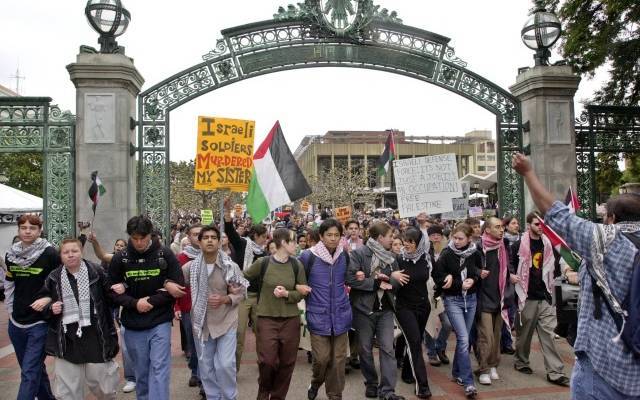While the video has some valuable information, I’m afraid it is undermined by the inaccuracies, political correctness and neglect of the most pernicious forms of anti-Semitism today.
By Mitchell Bard, JNS
Berkeley has been ground zero for campus anti-Israel activity for decades. Almost 40 years ago, I created the Israel Action Committee, and next to my table in Sproul Plaza were Arab students protesting the Lebanon War and the Muslim Students Association table with a sign that said “Zionism is racism” and a handout of the highlights of The Protocols of the Elders of Zion.
Today, Berkeley has probably the best Israel Studies program in the country, now celebrating its 10th anniversary, but the campus has remained a sometimes difficult place for Jewish students. It was therefore meritorious that a group of Cal educators produced an animated video on anti-Semitism they hope will be used nationwide. Unfortunately, the video has serious problems that need to be rectified before it is distributed.
The video begins with a nice overview of Judaism and the Jewish people’s relationship to Israel. It transitions to a history of anti-Semitism that explains its origins in Christianity and then jumps from the 15th century to the 19th century when it says that anti-Semitism changed from religious to racial hatred. This is problematic for two reasons.
First, perhaps for political correctness reasons, it focuses entirely on the West and ignores centuries of Muslim persecution. The narration suggests that European colonists brought anti-Semitism to the Middle East, ignoring what the Koran and other Islamic texts have to say about Jews. It is true Jews were treated worse in the Christian world; however, ignoring more than 1,000 years of history when Jews were considered dhimmis (second-class citizens) is a serious omission, made worse by the failure to discuss modern anti-Semitism in the Muslim world.
Second, and related to the first point, it’s absurd to suggest anti-Semitism ceased to be inspired by religious beliefs; the racial component was an additional justification for Jew-hatred.
The 30-second discussion of the Holocaust is also troubling. It mentions that 6 million Jews were killed but doesn’t explain what anti-Semitism had to do with their murder. The anti-Semitic aspect is also undercut by lumping in other minorities murdered by the Nazis. Only the Roma were targeted like the Jews for extermination. The narrator says the Holocaust was possible because of the support and apathy of millions of people in Europe. It was not just the Europeans, but people around the world, including the United States, whose silence and inaction played a role.
The video moves into a good summary of the core tenets of anti-Semitism and discrimination of Jews in the United States in the early 20th century. It goes off the rails, however, when it says that Jews are often seen as white “and benefited from anti-black racism.” The filmmakers have bought into—and now are perpetuating—the myth of Jews and white privilege even as they acknowledge in the next breath that Jews are victims of prejudice.
How exactly have Jews, specifically, profited or been responsible for racism in America? Isn’t singling Jews out as beneficiaries (no one else is mentioned) anti-Semitic? Would they also say that Jews have suffered because of affirmative action for blacks?
After accusing Jews of white privilege, the video later mentions that 12 percent to 15 percent of Jews define themselves as Jews of color. If you define yourself that way, does that mean you have not benefited from anti-black racism?
The video then contradicts itself when it correctly explains that associating Jews, who they should mention are not a race, with white privilege reinforces anti-Semitic stereotypes. The video can easily be corrected by deleting the previous section.
One of the most serious omissions is the failure to describe the “new anti-Semitism,” where Israel or Zionist is a proxy for Jews. This is at the heart of the problems on campus where, for example, BDS proponents transparently claim only to oppose Zionists and not Jews, while calling for the destruction of the Jewish state. Inexplicably, the video ignores BDS altogether, despite its malevolent impact on campus.
Seriously Damaging and Inaccurate Passage
Worse, the video drifts into the Palestinian issue in a seriously damaging and inaccurate passage. In its review of Zionism, it notes the achievement of the goal of statehood in the Jewish homeland and then, unnecessarily, adds this resulted in the displacement of “approximately 750,000 Palestinians” and “to this day, a Palestinian state has not been established and most Palestinians remain refugees.”
These few seconds of balderdash undermine the entire video and, worse, promote the Palestinian narrative that is the source of so much misinformation on North American college campuses.
1) What is a discussion of the Palestinians doing in a video on the history of anti-Semitism unless it is to discuss the decades-long history of Palestinian anti-Semitism? Where is the discussion of the Mufti, Palestinian textbooks and incitement? Earlier, the video claimed anti-Semitism was no longer religious. What about Hamas, an organization some anti-Semitic students support?
2) Israel wasn’t just “established.” It followed decades of Arab violence, provoked in part by religious hatred stoked by the Mufti, and a war fought against the invading Arab armies and some Palestinians.
3) Palestinians didn’t just become refugees. Most fled to get out of the crossfire of a war the Arab states started and hoped to return to a judenrein Palestine. Furthermore, the United Nations and CIA estimates of the number of refugees were less than 400,000 and Efraim Karsh surveyed all the Palestinian villages and arrived at a maximum of 609,000. The video plays into the hands of the anti-Semites by reinforcing their specious claim the Jews forced 750,000 Palestinians from their homes.
4) The majority of Palestinians are not refugees. Most Palestinians live in “Palestine.” Furthermore, even if you use the bogus UNRWA number of refugees (5.7 million) that’s only about 44 percent of the estimated Palestinian population of 13 million.
5) Why mention that Palestinians do not have a state in a film about anti-Semitism? First, it is irrelevant; second, it is out of context; and, third, it reinforces the Palestinian myth the Jews are responsible.
Why not mention that the Palestinians rejected partition and repeated offers of statehood since 1948, and that some Palestinians believe the land is Muslim and that it is inconceivable that Jews should have authority over them? What about the anti-Semitic Palestinian goal of a state replacing Israel? Why not add a map from the Palestinian Authority or one of its textbooks showing that Israel does not exist and that the land from the river to the sea is Palestine?
6) The film correctly mentions that Israel is a state for all Jews, but by leaving out that Israel grants equal rights to all its citizens, including Palestinians, it reinforces the anti-Semitic claim that Israel discriminates against non-Jews.
The most valuable parts of the video are examples of what is and is not anti-Semitic, but the content still fails to adequately address context even as it emphasizes its importance. There are three examples of critiques it says are not anti-Semitic: “opposing specific Israeli government policies,” “supporting Palestinians’ right to a state,” and “advocating for rights of Arabs in Israel.” Alone, these are not anti-Semitic, but if used in the context of BDS, for example, which also calls for the destruction of Israel, they are. Supporting Palestinian self-determination and rejecting Jewish self-determination is anti-Semitic.
Moreover, people don’t typically make such statements in the abstract. They usually have a history or an agenda that reveals their intent. For example, it’s one thing for Natalie Portman to criticize Israel, it’s another when Louis Farrakhan does.
While the video has some valuable information, I’m afraid it is undermined by the inaccuracies, political correctness and neglect of the most pernicious forms of anti-Semitism today.
The Academic Engagement Network made a good investment in the idea but should not be promoting the film without further edits.
I have a lot of respect for Hillel director Rabbi Adam Naftalin-Kelman, one of the driving forces behind the project. He has done a good job in a very tough environment. I wrote to him about some of these concerns hoping he would address them and obviate the need to publicly criticize the project. Alas, he did not respond. Perhaps if others reach out to him about the flaws in the video it can be reedited to have the intended impact.
Mitchell Bard is a foreign-policy analyst and an authority on U.S.-Israel relations who has written and edited 22 books, including “The Arab Lobby, Death to the Infidels: Radical Islam’s War Against the Jews” and “After Anatevka: Tevye in Palestine.”
MAKE THE LAND OF ISRAEL EVEN MORE BEAUTIFUL!
PLANT YOUR VERY OWN FRUIT TREES IN ISRAEL!
Farmers near the Gaza border lost family, friends and workers. Spring is here, and they desperately need help to replant the farms. Join us in blessing the People and Land of Israel.
“I will ordain My blessing for you…” (Leviticus 25:4)























